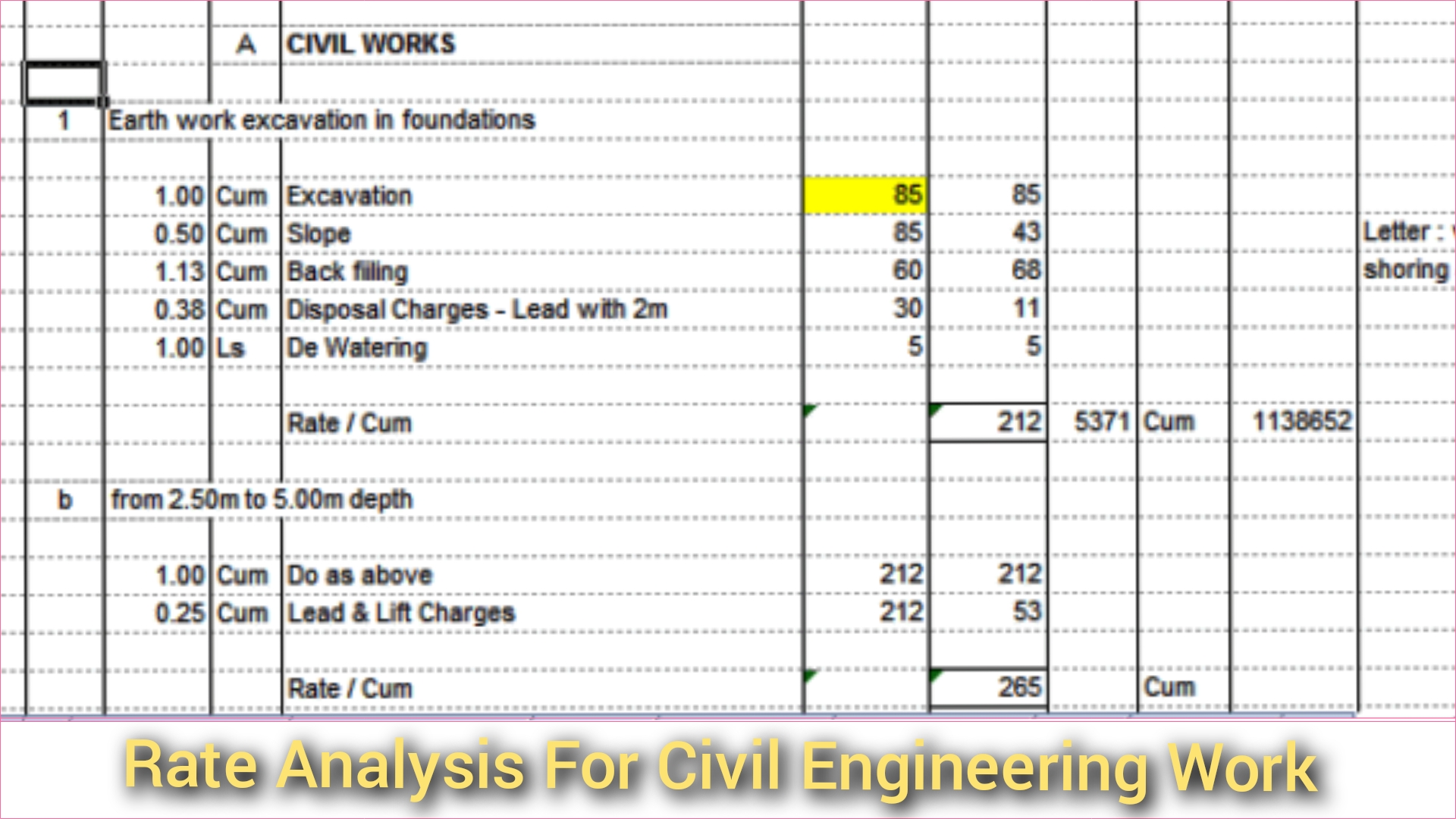Table of Contents
What Is Rate Analysis Of Civil Engineering Works?
Rate analysis is a very important concept in civil engineering works. There is a number of activities in every construction project like block work, concrete pouring, steel fixing, etc. In each and every activity, there are various civil engineering works involved.

Examples of some common activity during construction work are as follows:
- Excavation
- Flooring
- Waterproofing
- Concrete work
- Steel work
- Masonry work
- Interior designing
- MEP work
- Finishing work
- Plastering, painting, and whitewashing.
Earthwork is an exercise that is defined into different types based on soil and depth. For example, in soft soil, only 1meter deep earth is excavated and in hard soil, we excavate 3 meters of earth. Similarly concreting is divided into different types based on its mix proportion and its positioning. For Example, M20 and M25 concreting are done in foundation and M30 concreting in columns slabs, etc. Similarly, there are lots of civil works involved in construction.
The costing of the construction project is calculated by different civil works associated with different activities. So it is very much important to define and calculate the cost of each and every civil work.
Unit price of an item can be calculated by formula as given below:
Unit Price = Cost of Each Construction Work / Unit Quantity
And this cost is the cost of machinery, laborers, materials, profit of contractors, and other overall expenses required for work to be complete in unit quantity.
Let us understand by an example:
Example – Cost of 1 m3 of Excavation in the soft soil of 1.5m depth, Cost of 1 meter square of plasterwork of 12mm, cost of 1 m3 of M30 RCC work in the slab, cost of painting 1-meter square with specified paint in different layers as demand.
Material cost in rate analysis can be calculated as the aggregate cost of material, its transportation costs, taxes. The skill of labour determines labour cost i.e unskilled workers, semi-skilled, skilled labour and their cost is diversified from places to places.
Some Aspects Which Affects Rate Analysis In Civil Engineering Works
Following are some aspects which affects rate analysis of civil works:
- Specification of the works and material such as the proportion of mortar and concrete, plaster thickness, excavated depth, coats of paint, Soil type etc
- Construction site location – Construction site distance from the availability of material, labour, Availability of water, machinery etc. These aspects influence the rate analysis of construction work.
- Contractors profit, various expenses and other overhead expenses like accounting, rent, advertising, supplies, taxes, travel bills, labour burden, rents also influence the rate analysis.
- Material Quantity, different types of labours, material and labours rent influence the rate analysis.
Component of Rate Analysis in Civil Engineering Works:
Component which Completes the rate analysis are:
- Cost of Material with wastage
- Cost of Labour
- Machinery and plant owning renting and operating charges
- Charges of water and Electricity
- Taxes
- Risk and insurance coverage charges
- Contractors’ profits and Overheads.
Why In Construction Project Rates Analysis Is Required?
For following purposes rate analysis is required in Construction projects:
- Before tendering process rate of analysis is required. As in the case of tendering, the contractor can calculate the cost of unit work in each construction activity for quoting rates. A rate analysis sheet is also required by the client to calculate the cost of construction projects.
- To know the quantities of labor, materials, machinery, capital, and their requirement to complete the project.
- Most effective use of labor, machinery, and materials and to know different alternatives to optimize the resources.
- In case of dispute rate analysis sheet is taken to account among project owners and contractors.
- To know the unreasonable rates quoted by contactors during the process of tender.
- During various stages of construction works to rate analysis sheets are used to work out the construction project budget and control cash flows.
Closing Thought:
In this article, you have learned about rate analysis of civil engineering works. As we knows that most activities on a construction site are belong to construction works, hence, a civil engineer must have knowledge of rate analysis.
FAQS
It is the process of determining the cost of construction works based on various parameters like material cost, labor cost, and overhead cost.
It helps to estimate the cost of a work and make budgeting decisions.
Market price of materials, labor cost, transport cost, overhead costs, etc.
By using various tools and techniques like cost estimation, quantities take-off, cost analysis, etc.
Material cost, labor cost, overhead cost, indirect cost, etc.
It provides accurate cost estimation, helps in project budgeting, and assists in decision making.
By staying updated with market prices, using relevant software tools, and improving calculation methods.
It does not take into account changes in market prices and does not account for unforeseen events.
They are responsible for preparing cost estimates and rate analysis for construction projects.
Accurate rate analysis helps to ensure that project budgeting is realistic and adequate resources are allocated, impacting the success of the project.
Microsoft Excel, Ms Project and Primavera P6.
Read More Articles:
